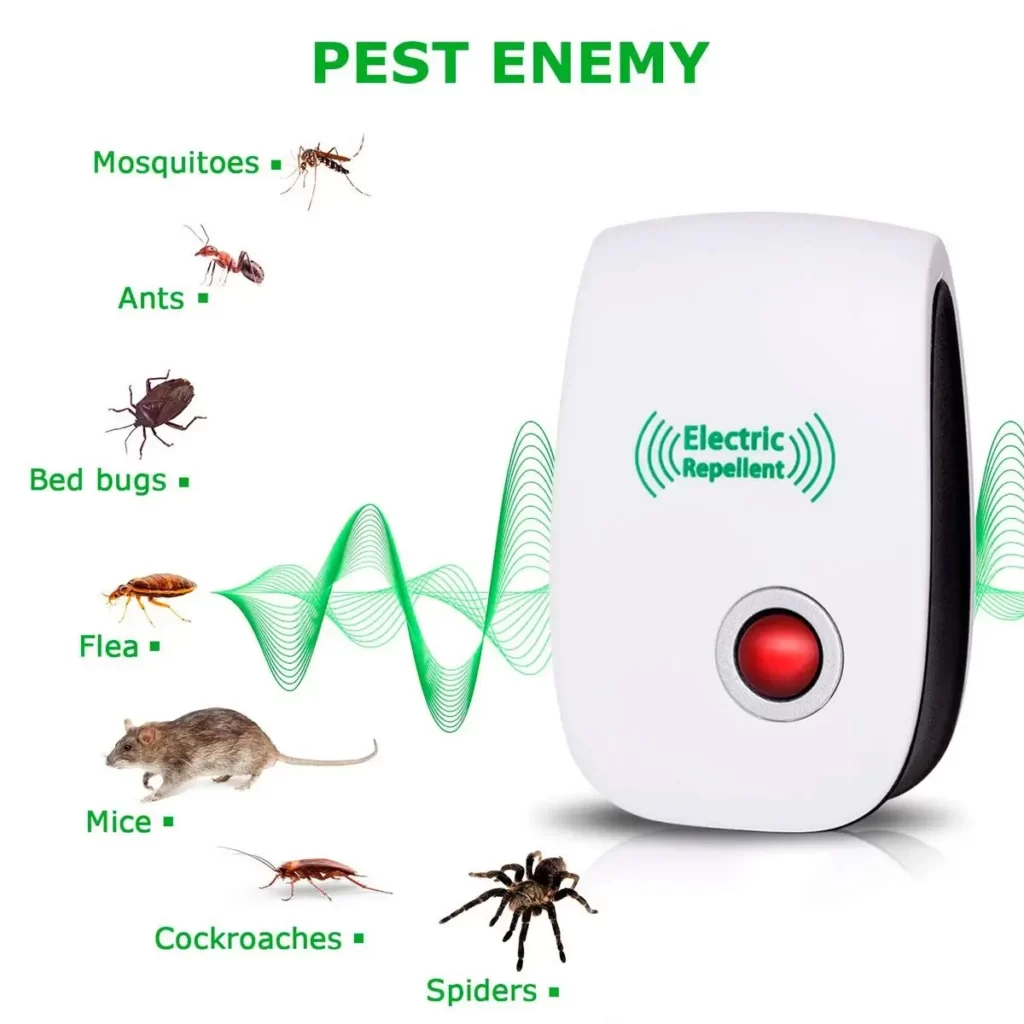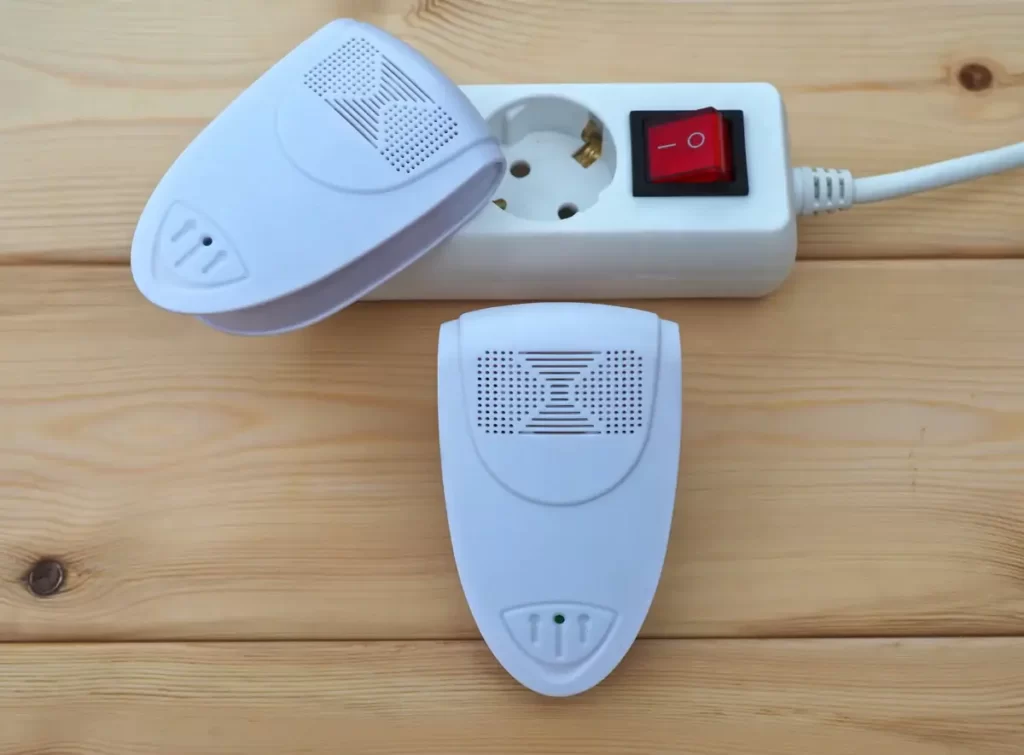Last Updated on August 2, 2023 By Emma W. Thomas
Ultrasonic pest repellers are generally considered safe for humans. They emit high-frequency sound waves that are typically harmless to people and pets but may deter certain pests. However, their effectiveness in pest control remains debated among experts.
Are Ultrasonic Pest Repellers Safe For Humans?
Ultrasonic pest repellers are common devices used in homes and gardens to deter various pests such as rodents and insects. By emitting sound frequencies beyond the range of human hearing, these devices claim to be non-toxic and harmless to humans. However, their safety has gone under scrutiny, raising concerns and debates.
2. Sound Emission Level
Ultrasonic pest repellers function by emitting high-frequency noises that deter pests. Typically, human beings cannot hear these sounds as they fall into the range of 20kHz to 65kHz. Hence, these devices are generally considered safe as they don’t directly impact humans physically.
3. Lack of Chemicals
Unlike traditional pest control methods which utilize poisonous pesticides and chemicals, ultrasonic pest repellers don’t release any toxins into the environment. Consequently, they pose no direct harm or health hazards to humans through air contamination or contact.
| Traditional Pest Control Methods | Ultrasonic Pest Repellers | |
|---|---|---|
| Chemicals Released | Yes | No |
| Direct Harm to Humans | Yes | No |
4. Impact on Domestic Pets
Although ultrasonic pest repellers are considered harmless to humans, their impact on domestic pets remains debatable. Some pets like dogs and cats can hear frequencies emitted by these devices, causing them distress or discomfort.
5. Lack of Scientific Evidence
Critics of ultrasonic pest repellers point out the lack of scientific evidence backing the safety of these devices. The absence of comprehensive study and research keeps the debate over their safety open.
6. Potential Side Effects
While they are generally considered safe, some people have reported discomfort like headaches after using ultrasonic pest repellers. Whether these symptoms are a direct result of the devices is yet to be ascertained, emphasizing the need for further research.
7. Regulation by Authorities
In many countries, certain authorities regulate the production and sale of ultrasonic pest repellers, ensuring they meet safety standards. However, the effectiveness and safety of these devices can vary significantly between brands, calling for user diligence.
In summary, ultrasonic pest repellers are generally considered safe for human use. They emit sounds at a frequency undetectable to humans and do not involve the use of harmful chemicals. However, their impact on pets and the lack of definitive scientific studies on their safety merit caution. Therefore, consumers must make informed decisions when purchasing these devices, including considering the specific needs of their household.
What Are Ultrasonic Pest Repellers?

Ultrasonic pest repellers are devices that emit sounds of short wavelength but high frequency and pitch to be heard by human ears. Few considerable individuals can hear such frequencies. However, animals such as dogs, bats, and rodents hear such ultrasonic sounds very well. For this reason, some people use ultrasonic sound as a pest control method. There have been questions on the effectiveness of the ultrasonic repeller, and just like any other pest control method, it has its side effects.
What Are The Side Effects Of Ultrasonic Pest Repellers?
The most common side effect of the repellers is that other than just the pests and rodents, pets within the home can also hear the high-pitched frequency. Some animals can hear ultrasonic sounds, such as dogs and rabbits, making them very uncomfortable. This method of pest control is therefore unsuitable in households with pets.
The other side effect is on human beings. When exposed to the ultrasonic emitter for a long time, some people can experience worse health problems. Some people tend to experience migraines, nausea, fatigue, and disorientation from prolonged exposure to the ultrasonic repeller. However, the effect is not common to human beings since only a few and considerable people can hear the ultrasonic sound.
Some users have also reported that the ultrasonic repellant interferes with telephone conversation clarity due to poor signals, burglar alarm systems, and in other cases, they cause hearing aids to mute. However, these are just claims, and further studies are yet to be undertaken to provide adequate information.
Why Do Ultrasonic Repellers Fail To Work?
Ultrasonic repellers may appear nifty, but they also fail at times. They fall short for the following reasons. First, rodents tend to hear the sound only for the first few days, making them startled. After some time, they get used to the ultrasonic sound, and they don’t get startled anymore. If the environment of one’s house is conducive enough for them, they continue living there without being distracted by the noise from the ultrasonic repeller.
Secondly, the ultrasonic repellers have short-range frequencies. High frequency of any wave, whether light or sound, is easily disrupted, leading to a short distance of effectiveness. The same case applies to the ultrasonic pest repeller, which has high frequencies blocked by foreign objects such as furniture. For this reason, they can only be effective over very short and straight distances, which may not be of much help in a household.
Most ultrasonic repellers work by plugging them into electrical sockets, limiting the locations where one can put them. Unless one is willing to run extension cords all over the house, the method may be ineffective. It could also pose risks associated with electrocution, especially in a household that has small kids. Rodents can avoid locations where the ultrasonic repellers are placed and proceed using another route through one’s house.
Does Ultrasonic Repeller Function The Same Way As The Electromagnetic Pest-Free Plug?
The electromagnetic pest-free plug is a pest control method used the same way as the ultrasonic repeller by connecting it to a plug. They, however, function differently. They have some differences in their operations, such as:
1. Ultrasonic only affects pests and insects in direct line of sight, whereas the electromagnetic plug alters the existing electromagnetic fields of an entire room. With this ability, they penetrate deep into the heart of the location where pests may be hiding, making it more effective.
2. Ultrasonic repeller affects all animals that can hear the high-pitched frequency they produce. They create an unhealthy environment for pets within a household, especially dogs and sometimes humans. On the other hand, an electromagnetic plug does not affect other animals such as cats and dogs, or even the electric flow in a home. It is safe for family use, for the environment, and also cost-effective with zero maintenance fee.
3. Electromagnetic pest-free plug device penetrates its electromagnetic waves through walls and other barriers. One only requires a single device from an entire household. On the other hand, several ultrasonic plugs are required since their high-frequency sound waves are easily blocked by barriers and only affect direct lines. For this reason, electromagnetic plugs tend to be more cost-effective than ultrasonic repellers.
4. Ultrasonic repeller works by producing high-pitched frequency sounds to scare away pests. On the other hand, the electromagnetic plug uses electromagnetics at predetermined level pulses to affect the metabolism of pests and rodents. Scientific studies and analyses have been carried out and proven its effectiveness.
Can Dogs Hear The Ultrasonic Repellant?
While humans cannot hear the ultrasonic repeller, it does not mean that dogs and other animals cannot. Some animals hear the sound from the repeller as they can hear high-frequency sounds. Dogs may be bothered at first, but they sometimes just let the sounds get over their heads. Different dogs react differently to sounds.
There are some signs that indicate the dog can hear the high-pitched sound from the pest repeller including; barking, whining, turning its head, tail tucking, sniffing around, and back hair on edge. Other signs may include flat ears, reluctance to go outdoors, staying close to people, and backing away for no reason.
How Does The Ultrasonic Repeller Work?
The Chinese were the first to adopt the idea of using sound as a pest control method and they used items that were manually operated. The sound emitted from these items expelled bugs and pests from crops in their fields. From this point, the idea of using ultrasonic repellers indoors was generated. As the name suggests, it means using a high-frequency sound of more than 20,000Hz. Such a high frequency goes undetected by human ears.
High-frequency sound is thought to have certain effects on pests, such as convulsions, confusion, and sometimes even death. These cases are referred to as audiogenic seizure responses. The ultrasonic repeller works by making pests leave the area with a high-frequency sound that causes them distress to a quieter and friendlier place.
What Kind Of Animals Do Ultrasonic Repellers Work On?
Ultrasonic repellers work on some pests and don’t work on others. The pests they affect depend on the type of ultrasonic device used. Some ultrasonic devices repel large pests such as squirrels and rats, whereas others work on fleas and flies.
However, the ultrasonic sound can affect other domesticated animals such as rabbits and dogs causing them distress. For this reason, some of these devices come with labels and warnings for such cases. Buyers should be careful and cautious to avoid creating an uncomfortable environment for their pets in the name of pest control.
Are Ultrasonic Repellers Cost-Effective?
When on normal use, an ultrasonic pest repeller can last up to three to four years on average. One can easily tell that an ultrasonic device is working by checking whether the LED light is on. Considering other methods such as spraying chemicals, it is cost-saving. One has to reapply repeatedly, whereas, for the ultrasonic repeller, all one has to do is turn on and off the electric sockets. They also do not require regular replacement since they have a long shelf life. It also saves labor costs as installation of the ultrasonic pest repeller only involves plugging in a socket.
Do Ultrasonic Repellers Work?

Many studies have been carried out due to various people questioning the efficacy of ultrasonic repellers as a pest control method. Most of these studies found that the device effectively repelled some insects such as crickets and cockroaches. Spiders and ants in most results from the studies were not affected.
These studies also stated that most of the pests affected by the ultrasonic device later became habituated. The sound did not affect them anymore upon realizing that the noise is harmless. Their conclusion on whether the device worked was that it works for the first few days. After that, the pests continue roaming the household undisturbed by the ultrasonic repeller’s high-frequency sounds.
Conclusion
Ultrasonic repellers use high-frequency sounds that the human ears cannot perceive. However, some individuals can hear it. The repeller does not affect humans when used for a short time. Most people who go for this method are environmentalists whose aim is to protect nature.
One may experience migraines and nausea associated with the ultrasonic repeller’s high pitch sounds if used for a long. It also affects other domesticated animals such as dogs and rabbits, creating a non-conducive and uncomfortable environment. Some of the noise produced by the ultrasonic repellers causes distress to these animals instead of controlling pests.
References:
https://pointe-pest.com/electronic-pest-repellers-harmful-human-hearing/
https://www.midwaypestmanagement.com/can-ultrasonic-mouse-repellents-cause-damage-to-humans/
Emma is a graduate of Domestic Science or Family and Consumer Sciences (Home Economics) from the University of Wisconsin. She has 7 years of experience Working with the strategic section of BestBuy and now writing full-time for Homeeon.
From Managing the Home, Interiors, Cleaning, and Exteriors to Gardening and everything about Making A Home Liveable – is her passion and this Homeeon is the result of this.
Emma loves decorating her home with the best stuff found online. She cares about quality over anything and writes reviews about them here in Homeeon. Get in touch with her over Pinterest.
Keep reading her blogs.

